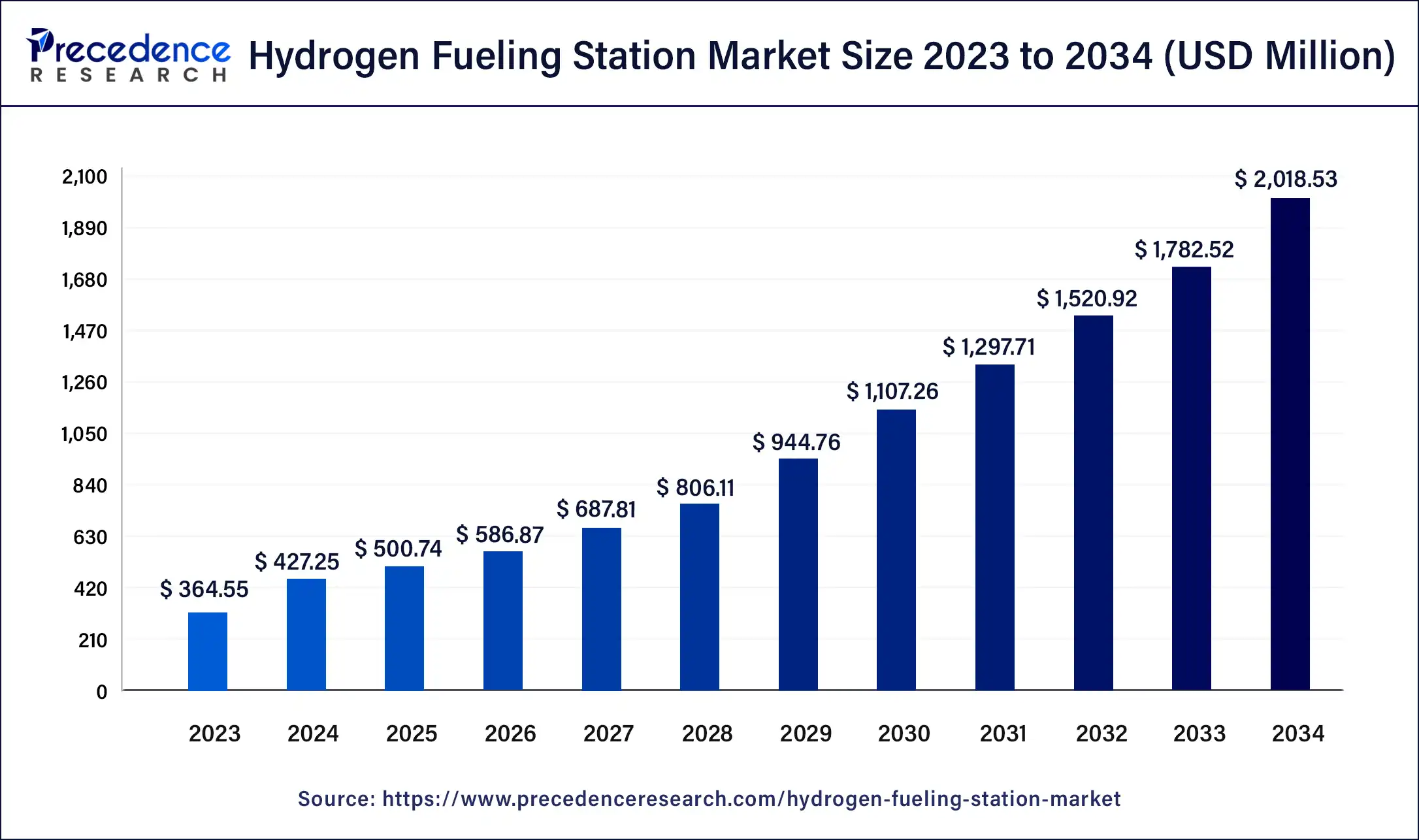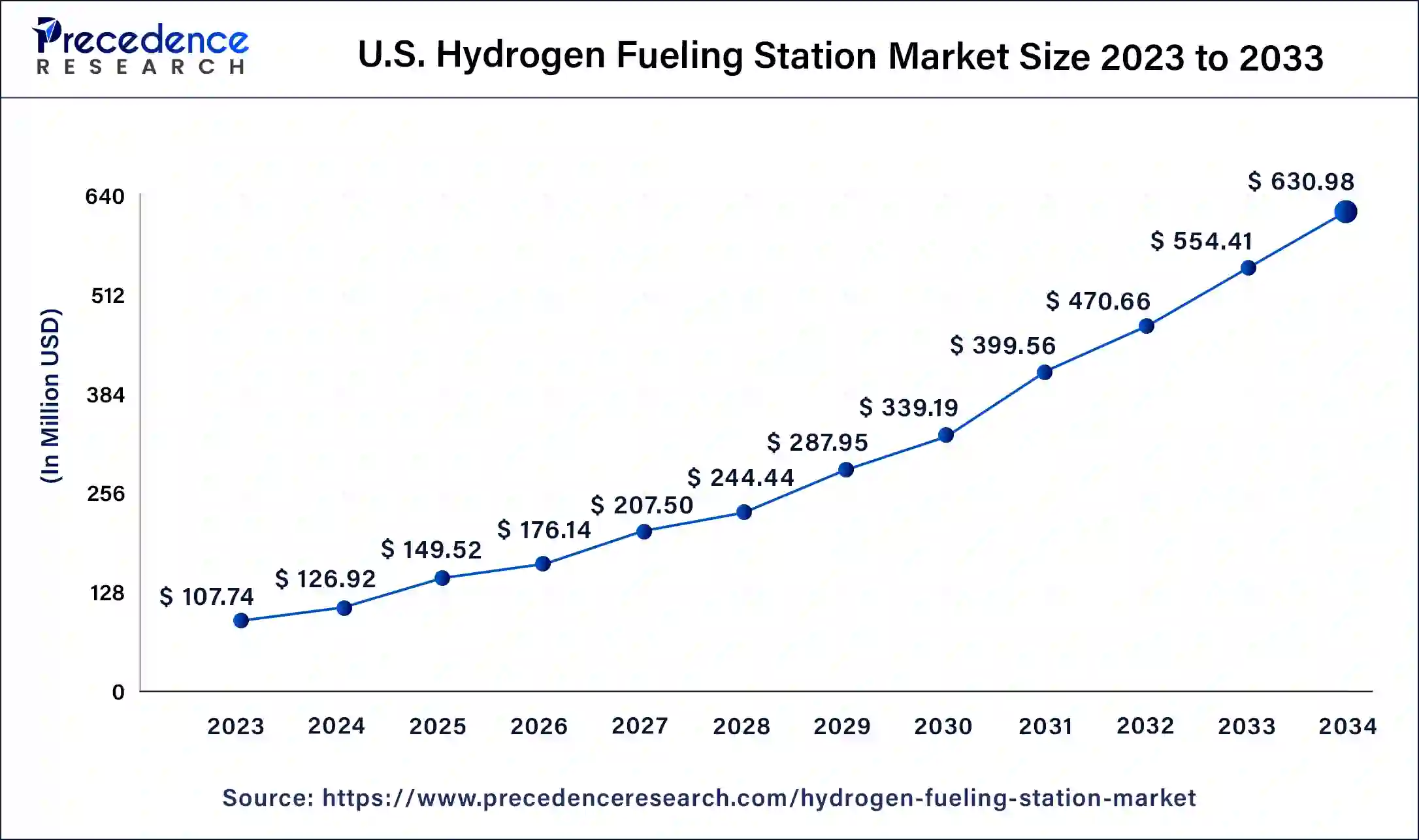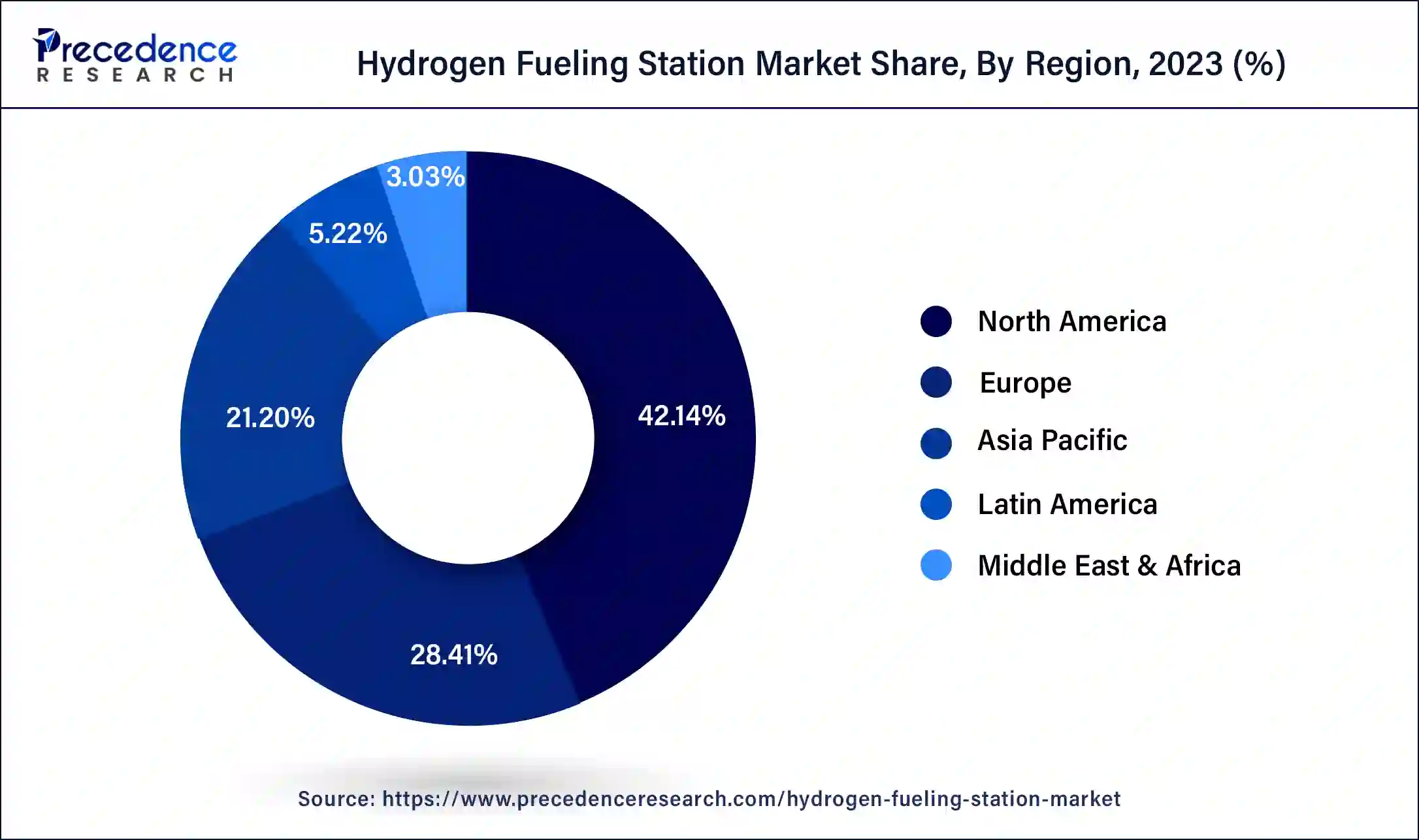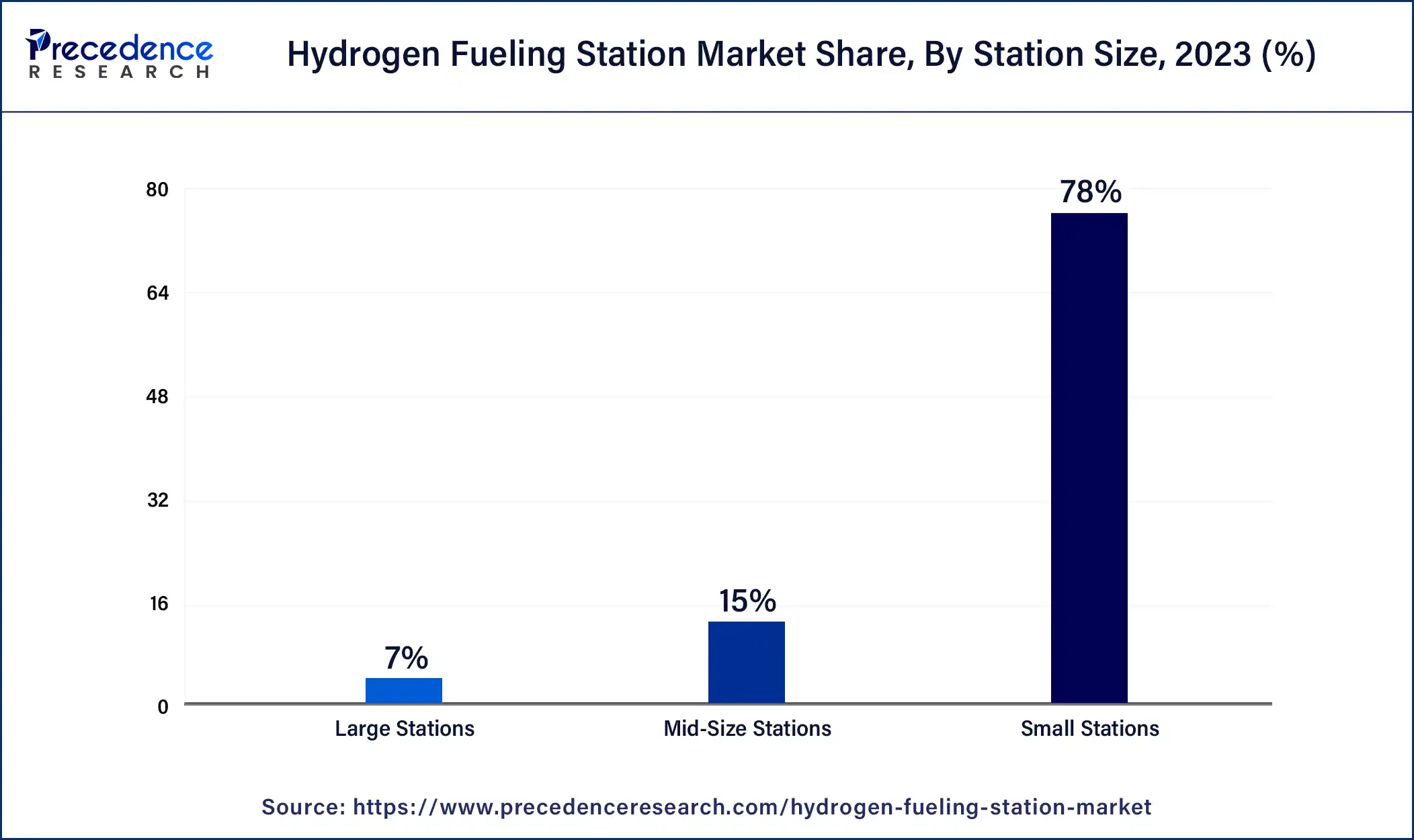April 2025
Hydrogen Fueling Station Market (By Station Size: Small Stations, Mid-Size Stations, Large Stations; By Supply Type: Off-Site, On-Site; By Pressure: High Pressure, Low Pressure; By Station Type: Fixed Hydrogen Stations, Mobile Hydrogen Stations; By Solution: Engineering Procurement and Construction, Components) - Global Industry Analysis, Size, Share, Growth, Trends, Regional Outlook, and Forecast 2024-2034
The global hydrogen fueling station market size was USD 364.55 million in 2023, accounted for USD 427.25 million in 2024, and is expected to reach around USD 2,018.53 million by 2034, expanding at a CAGR of 16.8% from 2024 to 2034.

The U.S. hydrogen fueling station market size was estimated at USD 107.74 million in 2023 and is predicted to be worth around USD 630.98 million by 2034, at a CAGR of 17.4% from 2024 to 2034.

The hydrogen fueling stations market is spread across North America, Europe, Asia Pacific (APAC), the Middle East and Africa, and Latin America. North America (NA) held a high share of the global hydrogen fueling stations market in 2023. In 2023, the United States held the highest share followed by Canada and Mexico. Considering the presence of nations with lucrative economic policies, high gross domestic product (GDP), and early adoption of the latest hydrogen fuel station technologies, the North American hydrogen fueling stations market is anticipated to grow remarkably.
The U.S. Department of Energy launched H2USA for hydrogen infrastructure. H2USA is a public-private collaboration with automakers, federal agencies, fuel cell developers, hydrogen providers, national laboratories, and other stakeholders. H2USA is mainly focused to advance hydrogen infrastructure and providing more transportation energy alternatives for U.S. consumers.
The European hydrogen fueling stations market is segmented into France, Germany, the United Kingdom (UK), Italy, and the Rest of Europe. Germany is estimated to hold the highest share of the European hydrogen fueling stations market during the study period. In May 2020, the government of France announced an aid package of $8.8 billion (€8 billion) to support the automotive sector. This aid package was intended to help the automotive sector in recovering from the adverse effects of the pandemic of COVID-19.
European Union (EU) states have agreed to construct hydrogen fueling stations across all major cities. In March 2023, the European Parliament and the Council of Ministers reached a political agreement on the regulations for deploying alternative fuel infrastructure. A hydrogen fueling station will be built at least every 200 kilometers along the core Trans-European Transport Network (TEN-T).
The hydrogen fueling stations market in the Asia Pacific (APAC) region is segmented into China, India, Japan, South Korea, and the rest of the Asia Pacific (APAC) region. In 203, China dominated the Asia Pacific (APAC) hydrogen fueling stations market followed by Japan and India.
Latin America, Middle East, and African (LAMEA) hydrogen fueling stations market is segmented into South Africa, Saudi Arabia, North Africa, Brazil, Argentina, and the Rest of LAMEA. The Latin America region is expected to account for considerable growth in the hydrogen fueling stations market during the forecast period. In 2023, Brazil had the highest market share in the LAMEA hydrogen fueling stations market region. Owing to low literacy, uncertainty, and unfavorable conditions in African countries, the hydrogen fueling stations market in the African region is predicted to grow at a slower rate.

Market Overview
A hydrogen refueling station is built with a broad range of accumulators and compressors to store and fill gaseous or liquefied hydrogen effectively. Hydrogen has emerged as an effective alternative to various fossil fuels. The rising concerns for a carbon-neutral environment and numerous initiatives from respective government authorities are enhancing the adoption of fuel cell electric vehicles (FCEVs) across various countries in the world. A usual passenger car emits around 4.6 metric tons of carbon dioxide (CO2) every year. For mitigating harmful carbon emissions, particularly in the transport sector, various governments are offering incentives, tax reliefs, and subsidies for new car buyers.
To enhance the effectiveness of hydrogen fueling stations, research and development (R&D) activities are carried out to develop innovative technologies. Some of the innovative technologies include electrolyzer-based onsite hydrogen refueling stations.
The increasing inclination towards owning a personal vehicle and rising disposable income are prominently contributing to clean vehicle sales in various developed countries. According to the data published by the U.S. Bureau of Economics, Disposable Personal Income increased by $2.13 trillion and personal income rose by about $1.97 trillion (10.5%) in April 2020. The stringent norms with respect to carbon dioxide (CO2) and the introduction of Carbon Pollution Standards by the U.S. Environmental Protection Agency (EPA) are encouraging the demand for environmentally friendly vehicles considerably.
In December 2020, California Energy Commission approved a plan that involves an investment of around $115 million. This plan is aimed to support the construction of hydrogen fueling stations. This investment is expected to support California in achieving its goal of deploying 200 public hydrogen fueling stations.
Government authorities in the United States (US), the United Kingdom (UK), Canada, South Korea, Germany, and Mexico have implemented various policies for developing H2-based fuels. To ensure a steady supply of hydrogen for clean-fuel vehicles, the South Korean government has decided to deliver 17,000 hydrogen vehicles and construct 91 hydrogen refueling stations. By mid-2021, 48 retail hydrogen fueling stations were opened in the US. Most of the hydrogen fueling stations are planned for California, 14 for the Northeastern states, and 1 for Hawaii.
The count of large hydrogen fueling stations in the US is estimated to be around 4,300 by 2030. This estimated count is around 70 times the count of operational large hydrogen fueling stations in the US in 2019.
| Report Coverage | Details |
| Market Size in 2023 | USD 364.55 Million |
| Market Size in 2024 | USD 427.25 Million |
| Market Size by 2034 | USD 2,018.53 Million |
| Growth Rate from 2024 to 2034 | CAGR of 16.8% |
| Largest Market | North America |
| Base Year | 2023 |
| Forecast Period | 2024 to 2034 |
| Segments Covered | By Station Size, By Supply Type, By Pressure, By Station Type, and By Solution |
| Regions Covered | North America, Europe, Asia-Pacific, Latin America, and Middle East & Africa |
Rising fuel cell vehicle adoption
As more consumers adopt fuel cell vehicles, the demand for fueling stations is observed to increase. The availability of well-developed hydrogen fueling station network provides confidence to consumers interested in purchasing fuel cell vehicles. The growth in fuel cell adoption creates a positive feedback loop for the hydrogen refueling stations market. With this adoption, the increased demand for stations attracts multiple private investments for the expansion of station networks.
The need to fuel more fuel cell vehicles drives research and development activities in the hydrogen production market, leading to advancements and cost reductions in hydrogen generation methods. Thus, the rising fuel cell vehicle adoption is observed to act as a driver for the market.
Safety concerns
Hydrogen fuel is considered when handled properly. Though, multiple safety concerns are observed to create a restraint for the market’s growth. Hydrogen is highly flammable as the risk of leakage from fueling stations or during transportation poses safety concerns. Although the fueling infrastructure employs safety measures and protocols to minimize such risks. Due to safety considerations, hydrogen fueling stations need to be located away from densely populated areas and potential ignition sources. This requirement can limit suitable locations for stations. Thus, such safety concerns hinder the growth of the market.
Government support and initiative
Governments in several countries are focusing on offering financial support in the form of subsidies and fundings to incentivize the establishment of hydrogen fueling infrastructure. This financial assistance can help offset the high initial costs and encourage private investments. Government's support also comes in the form of clear and favorable regulatory frameworks. Such guidelines and regulations by government can bring stability in the market. Recently, many governments have started setting ambitious emission reduction targets to combat climate change. This element also brings a chance for the market to achieve substantial support from government for the production of infrastructure for hydrogen fueling purposes.
Lack of consumer awareness
Consumer awareness plays a crucial role in shaping the demand for any product. If potential consumers are not aware of the benefits and advantages of hydrogen-powered vehicles, they are less likely to consider purchasing them. Building and operating hydrogen fueling stations require private and substantial investment. Whereas the lack of consumer awareness about hydrogen-powered applications can limit the investments in the market by investors. Consumers often hesitate to adopt new solutions, the lack of awareness and education about the benefits of hydrogen-powered vehicles can create a wrong perception for consumers. Thus, the lack of consumer awareness is observed to pose a challenge for the market.
COVID-19 Impact:
Logistical limitations, unavailability of the workforce, and other restrictions slowed the automobile industry's growth during the financial year 2020-2021. Shipment of various non-essential goods was restricted by numerous government authorities.
The COVID-19 pandemic impacted the domestic production of various passenger vehicles owing to the shutdown of manufacturing plants during lockdowns. With strict social distancing regulations, the production units of numerous original equipment manufacturers (OEMs) were completely shut down.
The transport of required raw materials was halted. Since the movement of people was drastically reduced, the need for an automobile also decreased exponentially. Owing to salary cuts or layoffs, the purchasing capacity of the people also decreased substantially. Due to the uncertainty caused by the COVID-19 pandemic, the car market declined by almost 18% In Ireland.
According to the United Nations World Tourism Organisation (UNWTO), international tourist arrivals across the globe in 2021 were about 421 million. This figure was 4.6% more than that of 2020 but 71.3% lesser as compared to 2019. The reduction in the count of tourists decreased the requirement for commercial passenger vehicles drastically. All the mentioned factors impacted the growth of the hydrogen fueling stations market enormously.
The situation started coming back to normalcy in the 2nd quarter of 2023. With increasing research and development (R&D) activities for efficient automotive fuel, the global hydrogen fueling stations market is estimated to grow notably during the forecast period.
Based on station size, the global hydrogen fueling stations market is segmented into small stations, mid-size stations, and large stations. The mid-size stations segment held the largest market share in 2023. The mid-size stations segment is predicted to grow with the highest compounded annual growth rate (CAGR) during the study period.

Based on supply type, the global hydrogen fueling stations market is segmented into off-site and on-site. The on-site segment had the highest revenue share in 2023. The on-site segment is estimated to grow with the highest compounded annual growth rate (CAGR) during the forecast period till 2034.
By pressure, the hydrogen fuel stations market is segmented into high-pressure and low-pressure. The high-pressure segment is anticipated to dominate the market during the forecast period.
Based on the station type, the global hydrogen fuel station market is segmented into fixed hydrogen stations and mobile hydrogen stations. The fixed hydrogen stations segment is estimated to dominate the market during the study period.
Recent Developments
Segments Covered in the Report
By Station Size
By Supply Type
By Pressure
By Station Type
By Solution
By Geography
For inquiries regarding discounts, bulk purchases, or customization requests, please contact us at sales@precedenceresearch.com
No cookie-cutter, only authentic analysis – take the 1st step to become a Precedence Research client
April 2025
September 2024
May 2024
May 2025